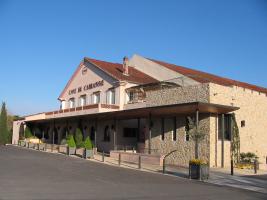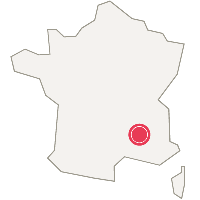You have no items in your shopping cart.
Vallée du Rhône
Cave de Cairanne
(27 customer reviews)
Cave de Cairanne is a wine cooperative located in the commune of Cairanne, in the Vaucluse department, in the Provence Alpes Côte d'Azur region. It markets southern Rhône Valley appellations such as Cairanne and Rasteau. Find out more
No wines available for sale
Vallée du Rhône : most popular Voir tous les vins de la région
The winemaker
Cave de Cairanne is a wine cooperative located in the commune of Cairanne, in the Vaucluse department, in the Provence Alpes Côte d'Azur region. It markets southern Rhône Valley appellations such as Cairanne and Rasteau.
Archaeological research has unearthed amphorae dating back to Roman times, attesting to wine production that was already well established in Antiquity. It has never ceased since.
In the 14th century, Pope John XXII was a fervent ambassador for Cairanne wines. During the annual tithe levy - the tax representing 10% of agricultural revenues paid to the Church - the Pope systematically demanded twelve barrels of Cairanne.
The Cave de Cairanne was founded in 1929. The region's winegrowers wanted to showcase their wines and preserve the specific characteristics of their terroir. They were the first to lay the foundations for the future appellations contrôlées. Rieu, one of Cairanne's winegrowers, took advantage of the impetus provided by Baron Le Roy - the man behind the revival of wine appellations in France - to unite the region's winegrowers.
This mobilization paid off, allowing winegrowers to put the name Cairanne on their bottles from 1953 onwards, and the Côtes du Rhône Villages Cairanne appellation was made official in 1967. It wasn't until 2018 that Cairanne was finally recognized as a Cru des Côtes du Rhône.
Today, the Cave de Cairanne groups together 65 winemakers who share the management of 550 hectares of vines.
The Cairanne vineyard covers only the commune of Cairanne. It covers 846 hectares, 550 of which are farmed by Cave de Cairanne winemakers. The terroir is quite varied and benefits overall from the dry, warm Mediterranean climate.
To the south, the garrigue plateau is mostly composed of stony alluvium, which blends with the finer grains of the soil. The plots benefit from exceptional sunshine, as well as the mistral wind that beats down on the vines. The wind dries and purifies the vines, repelling parasites.
The northern part of the terroir consists of the slopes of the Ventabren mountain. The soil consists of pebbles and limestone, with some traces of flint and marl.
The terraces to the west are composed of clay, fine sand and flint.
Cave de Cairanne's vineyards are 96% red and only 4% white. Half of the red grape varieties are Grenache. A further 30% is reserved for old Carignan vines and Cinsault. The remaining 20% is divided between Mourvèdre and Syrah.
The white grape varieties are 30% Clairette, 20% Grenache Blanc, 20% Roussane and the final 30% is shared between Viognier, Bourboulenc, Picpoul and Marsanne.
Red wines
Grande Réserve Rouge
Antique
Le Chêne Noir
White Wines
Grande Réserve White
Le Pas de Baume
Blanc Passion
Rosé wines
Le Chêne Givré Rose
Le Pas de Baume
The history of Cave de Cairanne
Archaeological research has unearthed amphorae dating back to Roman times, attesting to wine production that was already well established in Antiquity. It has never ceased since.
In the 14th century, Pope John XXII was a fervent ambassador for Cairanne wines. During the annual tithe levy - the tax representing 10% of agricultural revenues paid to the Church - the Pope systematically demanded twelve barrels of Cairanne.
The Cave de Cairanne was founded in 1929. The region's winegrowers wanted to showcase their wines and preserve the specific characteristics of their terroir. They were the first to lay the foundations for the future appellations contrôlées. Rieu, one of Cairanne's winegrowers, took advantage of the impetus provided by Baron Le Roy - the man behind the revival of wine appellations in France - to unite the region's winegrowers.
This mobilization paid off, allowing winegrowers to put the name Cairanne on their bottles from 1953 onwards, and the Côtes du Rhône Villages Cairanne appellation was made official in 1967. It wasn't until 2018 that Cairanne was finally recognized as a Cru des Côtes du Rhône.
Today, the Cave de Cairanne groups together 65 winemakers who share the management of 550 hectares of vines.
The Cave de Cairanne vineyard
The Cairanne vineyard covers only the commune of Cairanne. It covers 846 hectares, 550 of which are farmed by Cave de Cairanne winemakers. The terroir is quite varied and benefits overall from the dry, warm Mediterranean climate.
To the south, the garrigue plateau is mostly composed of stony alluvium, which blends with the finer grains of the soil. The plots benefit from exceptional sunshine, as well as the mistral wind that beats down on the vines. The wind dries and purifies the vines, repelling parasites.
The northern part of the terroir consists of the slopes of the Ventabren mountain. The soil consists of pebbles and limestone, with some traces of flint and marl.
The terraces to the west are composed of clay, fine sand and flint.
Cave de Cairanne's vineyards are 96% red and only 4% white. Half of the red grape varieties are Grenache. A further 30% is reserved for old Carignan vines and Cinsault. The remaining 20% is divided between Mourvèdre and Syrah.
The white grape varieties are 30% Clairette, 20% Grenache Blanc, 20% Roussane and the final 30% is shared between Viognier, Bourboulenc, Picpoul and Marsanne.
The wines
Red wines
Grande Réserve Rouge
Antique
Le Chêne Noir
White Wines
Grande Réserve White
Le Pas de Baume
Blanc Passion
Rosé wines
Le Chêne Givré Rose
Le Pas de Baume

Registered since 30/03/2016

290 Avenue de la Libération Cave de Cairanne,
84290 Cairanne
84290 Cairanne

0 wines available
between 0 € and 0 €
between 0 € and 0 €

282 wine's scans
on Twil application
on Twil application
Find our technical sheets on Twil app
| Reference | Colour | Vintage | Appellation | community_reviews |
|---|---|---|---|---|
| Château-Neuf-du-Pape | Rouge | 2015 | Châteauneuf-du-Pape | (2 reviews) |
| La Bête à Bon Dieu | Rouge | 2019 | Côtes-du-Rhône-Villages Plan-de-Dieu | (1 reviews) |
| L'insouciante | Rouge | 2019 | Côtes-du-Rhône | (1 reviews) |
| Cairanne Grande Réserve | Rouge | 2019 | Cairanne | (3 reviews) |
| Cairanne sans Soufre Ajouté | Rouge | 2017 | Cairanne | (1 reviews) |
| Cairanne | Rouge | 2015 | Côtes-du-Rhône-Villages | (1 reviews) |
| La Clef du Terroir | Rouge | 2014 | Cairanne | (1 reviews) |
| La Bête à Bon Dieu | Rouge | 2018 | Côtes-du-Rhône-Villages Plan-de-Dieu | (1 reviews) |
| Pas de la Beaume | Blanc | 2018 | Côtes-du-Rhône | not_rated |
| Secret de Campane | Blanc | 2017 | IGP Méditerranée | not_rated |
| Gigondas | Rouge | 2015 | Gigondas | not_rated |
| Rasteau | Rouge | 2017 | Rasteau | not_rated |
| La Réserve | Rouge | 2017 | Côtes-du-Rhône-Villages Plan-de-Dieu | not_rated |
| Le Chêne Noir | Rouge | 2017 | Côtes-du-Rhône-Villages | not_rated |
| Pas de la Beaume | Rouge | 2016 | Côtes-du-Rhône | not_rated |
| Pas de la Beaume | Rosé | 2018 | Côtes-du-Rhône | not_rated |
| Jardin Secret de Camille | Rouge | 2016 | Côtes-du-Rhône | not_rated |
| Secret de Campane | Rouge | 2017 | IGP Méditerranée | not_rated |
| Vacqueyras | Rouge | 2016 | Vacqueyras | not_rated |
| Château-Neuf-du-Pape | Rouge | 2016 | Châteauneuf-du-Pape | not_rated |



































 TWIL - Achat de Vin
TWIL - Achat de Vin


